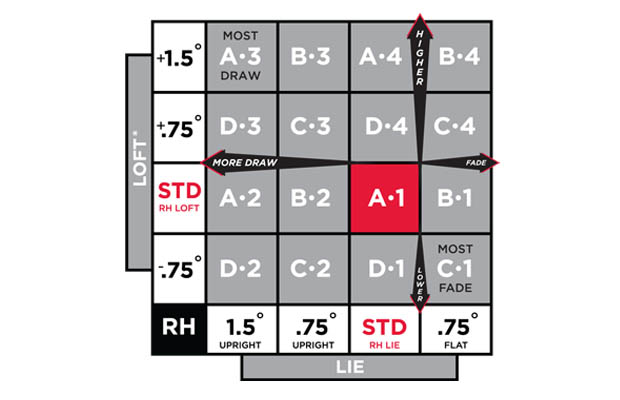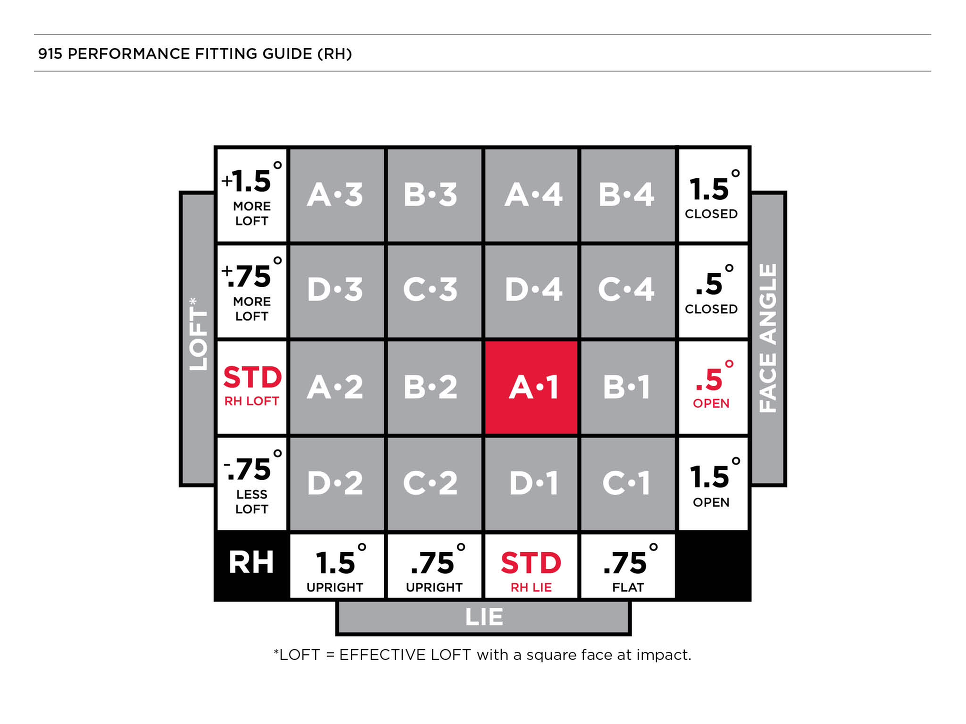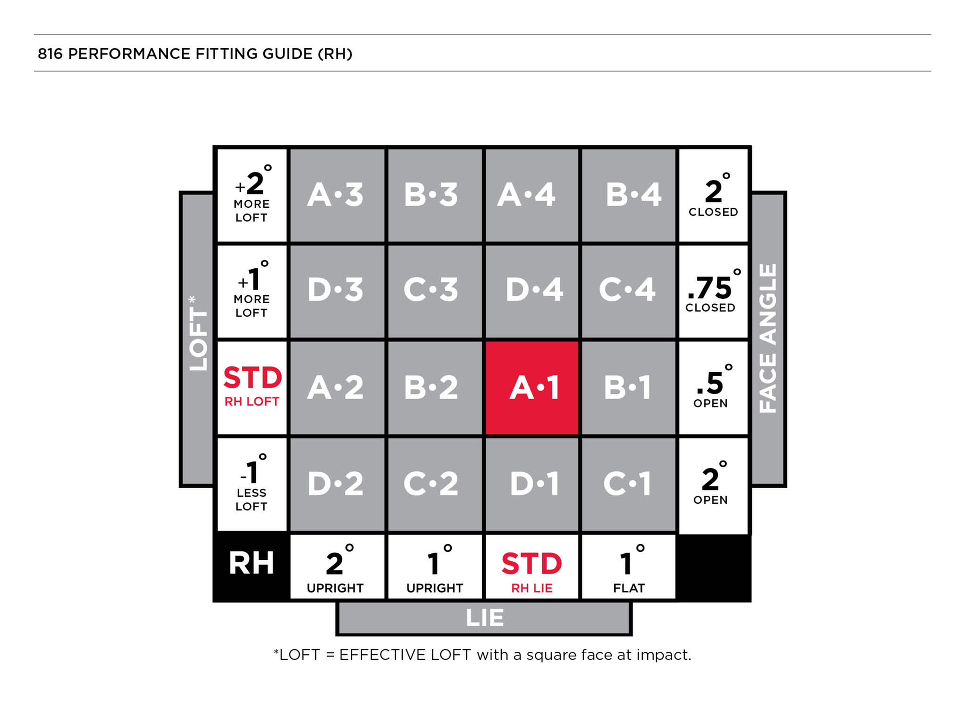…and how knowing exactly how it works can help your game
I have encountered many questions from consumers and golf industry employees as to what exactly happens when you change the setting on the Titleist SureFit Tour Hosel. Understanding how to use the Performance Fitting Chart and it’s 16 settings is vital to achieving the best launch conditions and getting the most out of your Titleist Driver, fairway metal, or hybrid.
For this example, lets use the 915 Performance Fitting Chart and a right-handed 9.5* Driver. In the A1 setting, the loft is the stated 9.5* with standard lie angle. If we are trying to achieve maximum height and launch with this current head/shaft combination, the appropriate setting would be A4. This setting mechanically adds 1.5* of loft, bringing us up to 11*. The important thing to keep in mind is that this loft change only takes place if you hold your Titleist Driver in the air and do not sole it. The reason for this is that when you add loft, you are effectively closing the face angle if you SOLE THE DRIVER ON THE GROUND. So, going from the A1 to A4 setting can lead to one of two scenarios. One, if the golfer never soles the club, squares the face, and he now has an 11* driver. Scenario two is that the golfer soles the club on the ground, takes his grip, and the driver is still 9.5* but the face angle is closed, adding a draw bias to the golf club. If you are a player that has to sole the club before you take your grip (most golfers are in my opinion) you are still in luck if you are trying to achieve 11*. Simply sole the club, open the clubface until it looks square or “normal” to you, take your grip and swing away. Some confusion arises around this topic because Titleist actually has two Charts. One is for consumers and this is what you will find with your literature when you purchase a Titleist Driver. The other chart, which has more information regarding face angle, is found in fitting guides that Titleist produces for PGA Professionals and golf club fitters. Below is the chart as you are probably used to seeing it…

As you can see there is no information regarding face angle. In my opinion this is acceptable as the extra information can tend to confuse some people. The most important thing to keep in mind is that when using this chart, if you are trying to achieve more or less loft, make sure you either square the face while the club is in the air, or you must first sole the club, open or close the club until it is square, and then take your grip. DO NOT sole the club and then immediately take your grip. If you do this you are simply playing with a different face angle, and did not change loft at all.
Now the other chart for club fitters looks like this….

You can see there is an entirely new chart on the right side that shows what the face angle adjustments are when you go up or down in the chart. For all Titleist metals, from the 910 series to the 816 hybrids, the A1 setting has the standard loft stated on the club and the face angle is .5* open. When going from A1 to D4, you can see the face angle goes from .5* open to .5* closed, one whole degree of face closure, and we will achieve an increase of loft of .75* when the face is squared. The reason behind this is that loft to face angle is about a .7/1 ratio… meaning for every 1* change in face angle, the effective loft when the clubface is squared is altered by about .7*. To make things easier Titleist rounds up to a more round number of .75*. If we continue to go up the chart to the A4 setting, you see we close the face one more degree, and add another .75* of loft when the face is squared.
How this information can help you play better golf:
Understanding how face angle plays a role in the SureFit Tour Hosel can really help golfers if they are having directional issues with their driver or metals. For example…
If you are hitting a Slice:
Your setting would 100% be A3. In this scenario, it is vital that you simply sole the club, and then take your grip. DO NOT SQUARE THE FACE because then you are taking your closed face angle and draw biased club out of the equation. In the A3 setting the face angle is 1.5* closed and the lie angle is 1.5* upright, which will furthermore help to effectively close the face at impact and eliminate your slice.
If you are hitting a Hook:
Your setting would be C1. Simply ground the club and take your normal grip and in play you will have a driver that sits 1.5* open with a .75* flat lie angle. Both of these specs will aid in keeping the face open during impact and help to avoid the left side of the golf course.
If you like the look of an open club face but want a draw bias:
Your setting would be A2. Here we do not change face angle at all, we are simply making the club more upright. Face angle is still .5* open (which is a very popular position for golfers of all abilities) but the lie angle will be 1.5* upright to aid in achieving your draw. This brings up the point that loft and lie can be changed independently with this system. As you know loft and face angle have a relationship when going up or down in the chart, but simply moving left or right in the chart ONLY changes lie angle, and keeps loft/face angle static.
Notes on face angle according to Titleist.com
-Golfers will react differently to changes in face angle.
-Some will square the face at impact and alter the loft.
-The head will have more loft when squared at impact if you start with a closed face angle.
-The head will have less loft when squared at impact if you start with an open face angle.
-Some will maintain the club’s static face angle and the resulting change in face angle will affect direction.
-A closed face angle will result in left ball flight.
-An open face angle will result in right ball flight.
-Some golfers will make a combination of these adjustments.
-The golfer’s ability to consistently return the club face at impact has a greater effect on directional control than the face angle setting.
-Ultimately, the golfer’s ball flight will be your best source of guidance regarding performance.
Source: http://titleist.com
Important points to keep in mind:
- For driver…each .75* change in loft changes launch by ½” and spin by 275 rpm
- For driver… each .75* change in lie angle will affect direction by 2 yards
- 915, 913, 910 driver heads and shafts are interchangeable
- 915 and 913 fairway heads and shafts are interchangeable
- 915 and 913 hybrid heads and shafts are interchangeable
- 910 fairway heads and shafts are NOT interchangeable with 915 and 913
- 910 hybrid heads and shafts are NOT interchangeable with 915 and 913
- 816 hosel adjusts in 1.0* loft & lie increments if used in 915 and 913 heads
- 915 and 913 hosel adjusts in .75* increments if used in 816 heads

Conclusion:
As you can see this post has a ton of detailed information. My intent was to give you all the necessary tools to help you find the SureFit setting that helps you get the most out of your Titleist equipment. If you have any questions please don’t hesitate to ask or comment below. Good luck!
Also, please comment below and tell me what clubs/ shafts/ balls you would like to be tested head to head.I will choose the most popular requests and post results ASAP.
You might also wanna check Titleist 716 AP1, 716 AP2: Review & Comparison.
Comments:
Matthew,
Fantastic piece.
The most complete, thorough and easy to read description regarding effect of face angle and lie.
I’ve been trying to find out whether my driver would remain at .5 degrees open if I only changed lie angle. This article clearly states that it will per the club fitters guide.
Time for me to determine if a different lie angle will better suit my game.
I will be saving this piece to my favorites list.
Thank you for your help.
All the best,
Ronan ConnollyRonan Connolly
Hi Ronan,
Thank you for the great feedback and you are correct…With Titleist you absolutely do not change face angle/ loft when you more left or right ONLY on the SureFit Chart. Please let me know if you have any other questions.Also, I apologize for not having a Newsletter sign-up… new to the whole blog thing and still learning.
Thanks for following,
DanKDanK
this is a great articleMark King
Thanks Mark for the feedback! If you have any other topics or questions you are interested in please let me know and I will try to help.DanK
Thanks for a very good explanation on Surefit. However, I need to ask about your recommendation if one is hitting a hook. It’s seems that for correcting a slice a higher loft is suggested (A3), which makes me think that a higher loft would also be good for correcting a hook. Still you recommend a lower loft. Why is that?Cheers
NicolaiNicolai
Hello Nicolia,Thank you for reading and for the question, I am happy to assist. If you are hitting a hook there are two things you can do to help you out. First I would recommend the B1 setting. Assuming you are in the neutral A1 setting currently, B1 will place the club .75* flat and provide more of a fade bias, which should help counteract your hook. The best thing with B1 is that you are not affecting loft or face angle. If B1 doesn’t offer enough assistance, go down to C1. The club will still be .75* flat, but now it will also be 1.5* open (face angle). The reason you should play C1, which is a lower lofted setting, is that in order to get the .75* less in loft that C1 provides, the club has to be opened by a full degree. In order to achieve your new “anti hook” setting, be sure to sole the club first, then take your grip and swing away. The club should seem flat and way open in regards to face angle. I hope this helps and please don’t hesitate if you have any further questions.
Take Care,
DanKDanK
Hi
would it follow that a short (5 6″)person will benefit from a flatter lie with the face squared ?
ThankyouGraham
Hello,The general rule of thumb is that shorter players could benefit from a flatter lie angle… but not always. Assuming we are discussing the driver, how is your ball flight with a std. lie angle? If the ball is going left predominantly, try B1. If the ball is going right, try going left on the SureFit Chart to a more upright lie angle such as A2 or B2. Good luck.
-DanKDanK
Hi Matthew,
The first useable article I have found on the net, great work!Im 44 years old, right handed a Hcp 15,2 golfer (been in Hcp 14,1 a couple of months ago)
I play with a “Diamana shaft D+70 x5ct Flex-S” with head 915D2 10.5 Degree..When I bought my driver last year I got my driver fitted, and at first the PGA pro put it into B2, as I had (what most amateur golfers have, outside/in swing path) and having problem with either a slice or a fade…
I got instructed in swinging Inside/out, returned 14 days later, he looked at my swing, and changede it to A1 (neutral) as I was standing there it all seemed to work, he left and that was it… But since, I tend to either slice the ball, OR starting med ballflight from Left to right, and the real trouble begins in windy conditions (wind from the left) because its like adding a lot of side spin to my ballflight, and it then instead turns into a slice.At the moment I have it in C3, (just to try something diffrent) but it´s like that´s to much loft for me, because I seem to sky it a bit, and it have a really high launch angle and I have lost like 20-30 yards or so, but with the same ballflight, (slice or Left to right)
But of course I do sometimes hit it dead straight, also in windy conditions, but my question is, can i neutralize this a bit by putting it in to C2 or D1.
Sole the club, open/ close the clubface until it looks square, take my grib and then swing away?hope I write so you can understand it, as Im from Denmark
Best Regards
John/ KeezJohn Keez Madisa
Hi John,Thanks for the question and positive feedback.
If your goal is maximum slice (lets call it a power fade) prevention, try A3. Make sure to sole the club (it should look closed), and then take your grip. The face angle will be 1.5* closed and 1.5* upright… all things to combat the dreaded left to right shot. Let me know how this works. Good luck!
-DanKDanK
Introducing the New Titleist 917 drivers, Tour Pros are Believers – USGolfTV – September 15, 2016 – 12:39 pm
[…] to chance in creating the perfect driver for Tour pros and average Joes. Their industry leading SureFit Hosel and SureFit CG weight system guarantee the best, most precise fitting for every […]
Mate this article is spot on.Went to the range today and tried a few different settings. I held the 915d2 driver in the air, tried to get the club face as square as I could, took my grip, addressed the ball without soling the club and took my swing. For the first time since I bought the club, which was ages ago, I could actually see the benefits of changing the settings.
My fave was A4, got the ball really high with a slight draw for me.Tommy
Awesome! I love to hear success stories. Any other topics you might want some insight on? I’m happy to help.-DanKDanK
It’s an amazing piece of writing designed for all the online users;
they will obtain advantage from it I am sure.(Your comment is awaiting moderation)Bandar Judi Bola
